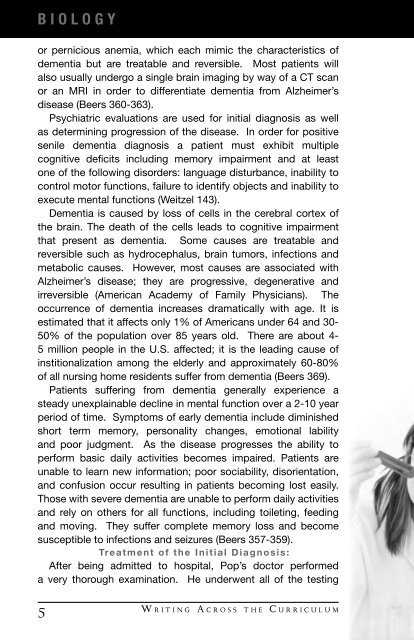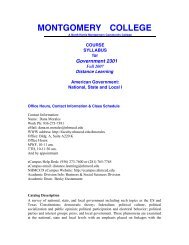2008 - Communication Across the Curriculum (CAC)
2008 - Communication Across the Curriculum (CAC)
2008 - Communication Across the Curriculum (CAC)
Create successful ePaper yourself
Turn your PDF publications into a flip-book with our unique Google optimized e-Paper software.
B i o l o g y<br />
or pernicious anemia, which each mimic <strong>the</strong> characteristics of<br />
dementia but are treatable and reversible. Most patients will<br />
also usually undergo a single brain imaging by way of a CT scan<br />
or an MRI in order to differentiate dementia from Alzheimer’s<br />
disease (Beers 360-363).<br />
Psychiatric evaluations are used for initial diagnosis as well<br />
as determining progression of <strong>the</strong> disease. In order for positive<br />
senile dementia diagnosis a patient must exhibit multiple<br />
cognitive deficits including memory impairment and at least<br />
one of <strong>the</strong> following disorders: language disturbance, inability to<br />
control motor functions, failure to identify objects and inability to<br />
execute mental functions (Weitzel 143).<br />
Dementia is caused by loss of cells in <strong>the</strong> cerebral cortex of<br />
<strong>the</strong> brain. The death of <strong>the</strong> cells leads to cognitive impairment<br />
that present as dementia. Some causes are treatable and<br />
reversible such as hydrocephalus, brain tumors, infections and<br />
metabolic causes. However, most causes are associated with<br />
Alzheimer’s disease; <strong>the</strong>y are progressive, degenerative and<br />
irreversible (American Academy of Family Physicians). The<br />
occurrence of dementia increases dramatically with age. It is<br />
estimated that it affects only 1% of Americans under 64 and 30-<br />
50% of <strong>the</strong> population over 85 years old. There are about 4-<br />
5 million people in <strong>the</strong> U.S. affected; it is <strong>the</strong> leading cause of<br />
institionalization among <strong>the</strong> elderly and approximately 60-80%<br />
of all nursing home residents suffer from dementia (Beers 369).<br />
Patients suffering from dementia generally experience a<br />
steady unexplainable decline in mental function over a 2-10 year<br />
period of time. Symptoms of early dementia include diminished<br />
short term memory, personality changes, emotional lability<br />
and poor judgment. As <strong>the</strong> disease progresses <strong>the</strong> ability to<br />
perform basic daily activities becomes impaired. Patients are<br />
unable to learn new information; poor sociability, disorientation,<br />
and confusion occur resulting in patients becoming lost easily.<br />
Those with severe dementia are unable to perform daily activities<br />
and rely on o<strong>the</strong>rs for all functions, including toileting, feeding<br />
and moving. They suffer complete memory loss and become<br />
susceptible to infections and seizures (Beers 357-359).<br />
Treatment of <strong>the</strong> Initial Diagnosis:<br />
After being admitted to hospital, Pop’s doctor performed<br />
a very thorough examination. He underwent all of <strong>the</strong> testing<br />
5<br />
W r i t i n g A c r o s s t h e C u r r i c u l u m






